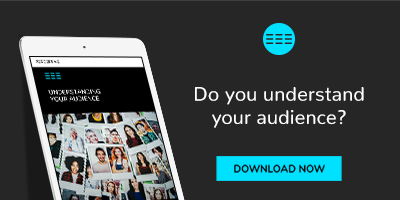If you’re looking to do more with your customer segmentation, take a look at these seven advanced segmentation strategies. From re-evaluating and refining your segments to discovering new customer groups that have flown under your radar, these strategies will help you see your customers in a new light and enhance your marketing performance.

Related content: Understanding Your Audience [Free Online Guide]
1. RFM modelling
Known as recency, frequency and monetary modelling, this strategy groups customers according to their customer lifetime value. To do this, the RFM model scores customers according to how recently they’ve purchased (Recency), how often they purchase (Frequency), and how much they spend (Monetary). Segments with the highest scores are considered the most valuable while those with the lowest are the least valuable.
RFM modelling is an excellent way to improve the targeting of your marketing and promotions. It allows businesses to target specific segments with promotions most likely to appeal to them to encourage them to move into a higher value segment. For example, if you have a high spend, low recency and low-frequency segment, you may choose to target this audience with a limited-time offer to encourage them to visit more frequently. Meanwhile, for a segment that’s low spend, high frequency, you may opt to give them a discount code to encourage them to spend more the next time they shop with you.
Related content: RFM modelling: a powerful customer segmentation tool | How data modelling and segmentation helped Burger King grow their app revenue by over 90 per cent
2. Factor segmentation
If you’re dealing with written responses—be it from customer feedback or an open-ended survey question—factor segmentation is one way to help organise comments into certain themes or factors. For example, if customers were asked to give a reason why they recommended your product, they might write “its prices are competitive” or “the products are worth what I paid for”. With factor analysis, both these comments would be grouped together under ‘value for money’ factor.
These factors can also be ranked in terms of importance to your customers and potential consumers, which can guide how you position your brand, and develop and market your offering(s) as well as the types of consumers you target.
3. Psychographic segmentation
Psychographic segmentation groups consumers according to personality traits, opinions, attitudes, beliefs (both conscious and unconscious), perceptions and motivations. It is an excellent way to not only understand the mindset of your customers and potential consumers but also understand the drivers that encourage groups of consumers to purchase.
This kind of segmentation has a variety of uses, from creative testing advertising, pack design testing and identifying your strongest brand assets to brand positioning, messaging, the types of promotions you put together and more. It’s also useful for predicting how your customers will respond to various messaging.
Psychographic segmentation is particularly powerful when used alongside uplift modelling as it can help clarify how customers will respond to a promotional offer. We will go into more about uplift modelling below.
4. Propensity and uplift modelling
Propensity modelling is a form of predictive modelling that assess the likelihood a customer will perform a certain action. This action could be to buy your product or to churn from your business. This type of segmentation is particularly useful for targeting customers with the right offer at the right time, be it an email promotion to prevent them from churning or an offer that will give them the final push they need to convert from a lead to a sale.
Uplift modelling is a type of propensity modelling that identifies customers who will only buy if targeted with a promotion.
Read more: End of the guessing game: a theoretical exercise in data modelling
5. Needs-based segmentation using K-Means and Random Forest machine learning
Machine learning segmentation is usually the “phase two” part of a segmentation project. Using an unsupervised algorithm, machine learning segmentation will group your segments into clusters based on their similarities. It is a way to re-evaluate your segments and find similarities between customer groups that might have previously gone undetected. Moreover, it not only helps refine your customer segments but also to reduce the number of segments you have your “phase one” segmentation has yielded too many groups to feasibly work with.
There are various algorithms available, but the most common we use are:
- K-Means clustering: good for either all numeric or all categorical data but doesn’t do well when the data is a mix of numeric and categorical. It performs well on smaller data sets but will struggle to scale. Sensitive to outliers. It requires a user to input the number of clusters desired.
- Random Forest: can be used for classification and regression projects. Is good at predicting customer behaviour with a higher degree of accuracy compared to other algorithms. Can handle data sets with missing data. Good with large data sets. Unfortunately, running Random Forest modelling requires more computational resources and time than other algorithms.
6. eCommerce purchase intent segmentation
eCommerce purchase intent segmentation is a form of behaviour segmentation that examines customer journey data to find groups of customers who display a similar set of behaviours that indicate purchase intent. This segmentation is often used to separate customers who truly intend to buy versus those at an earlier stage of the customer journey (and are not ready to buy). It is an excellent way to optimise your marketing campaigns to ensure they target customers at the right point in the customer journey.
7. Purchase latency/Order gap analysis
Similar to purchase intent segmentation is purchase latency, also known as order gap analysis. This type of segmentation delves into your customer data to understand the frequency various groups of customers order from you. Segmenting your customers this way can help you understand when they are likely to purchase from you again based on when they last ordered. Moreover, it is a useful tool to alert you to customers whose purchasing latency is much longer than normal, indicating they have churned or are about to.
Purchase latency segmentation is also particularly effective for B2B brands.
Learn more about the power of segmentation and how it enhances marketing and cut-through with our all-in-one guide: Understanding Your Audience.
